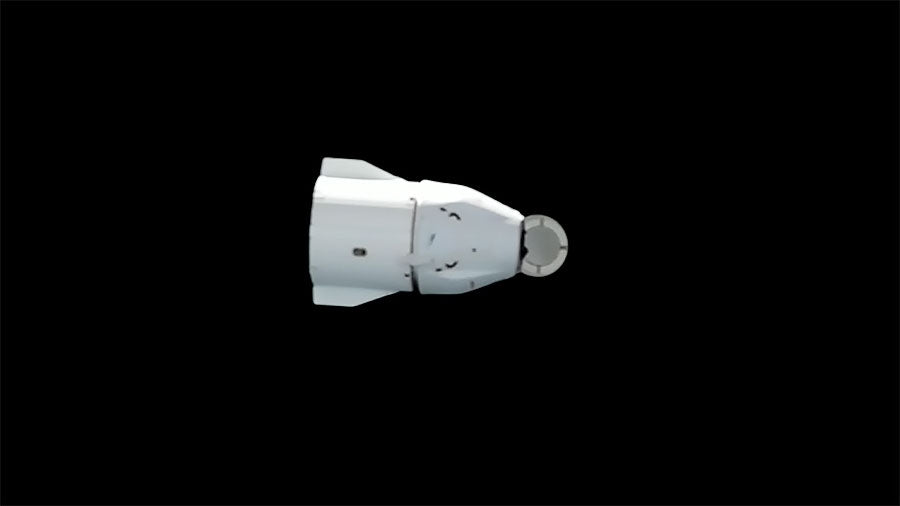SpaceX’s Dragon spacecraft is bringing around 4,400 pounds of cargo from the orbiting laboratory back to Earth to complete the 26th NASA Commercial Resupply Services (CRS-26) mission at the International Space Station (ISS). CRS-26 was launched by a Falcon 9 rocket on November 26 from Launch Pad-39A at the Kennedy Space Center and delivered over 7,700 pounds of cargo, including a large roll-out solar array to upgrade the ISS power system and Thanksgiving treats for the astronauts working in orbit.
LIVE: @SpaceX's Dragon cargo craft is bringing tons of @ISS_Research, including a space radiation vest and orbiting plant experiments, back to Earth.
— NASA (@NASA) January 9, 2023
Undocking is scheduled to start shortly after 5pm ET (2200 UTC). https://t.co/Ky6In8QW9P
After 43-days, Dragon undocked from the orbiting laboratory on January 9 at 5:05 p.m. ET while the ISS was flying about 259 miles over the Pacific Ocean. –“Separation confirmed! Dragon is performing three departure burns to move away from the Space Station. Splashdown in ~36 hours,” announced SpaceX after the autonomous undocking sequence was complete. The uncrewed Dragon capsule is heading back to Earth with full autonomy, while engineers monitor operations from SpaceX Mission Control. The undocking operation was supervised by the Expedition 68 astronauts currently working at the ISS Lab.
Separation confirmed! Dragon is performing three departure burns to move away from the @space_station. Splashdown in ~36 hours
— SpaceX (@SpaceX) January 9, 2023
Dragon CRS-26 will reenter Earth’s rough atmosphere on Wednesday, January 11; It will make a parachute-assisted splashdown off the coast of Florida at around 5:19 a.m. ET. However, NASA does not plan to broadcast the ocean landing, nor vehicle recovery. A SpaceX recovery ship will fish-out Dragon out of the salty water as soon as possible to rapidly extract some of the vital cargo the capsule is carrying, which include the results of important science research conducted in microgravity. To minimize the effects of gravity affecting the science experiments’ results, teams must rapidly deliver the cargo back to special facilities at NASA Kennedy Space Center where they will then be handed to their respective researchers and rapidly flown to laboratories around the world. Some of the scientific research Dragon CRS-26 is bringing back to Earth includes:
- Deep space radiation protection: A vest designed to protect astronauts from high doses of radiation caused by unpredictable solar particle events is returning to Earth after months of testing. Crew members wore the Astrorad vest [pictured below] while performing daily tasks and provided feedback about how easy it is to put on, how it fits and feels, and the range of motion possible while wearing it. The vest’s developers plan to use that feedback to improve design of the garment, which could provide radiation protection for astronauts on Artemis missions to the Moon.

- Air, water, plants: XROOTS used hydroponic (water-based) and aeroponic (air-based) techniques to grow plants without soil or other growth media [pictured below]. Researchers collected video and still images to evaluate growth chambers through the plant life cycle from seed germination through maturity. The plant chambers are returning to Earth for additional analysis. Similar techniques could be used to produce crops for future space missions and to enhance cultivation and food security for the benefit of people on Earth.

- Bioprospecting in space: Bioprospecting is the process of identifying plants and animals that may contain substances with potential for use as drugs, biochemicals, and more. Previous studies found that space can cause genetic and physiological changes that could result in microbes yielding such materials. Rhodium Microgravity Bioprospecting-1 studied a way to search for these microbes. The science chambers and temperature logger from the investigation are returning to Earth for further examination. Source: Science research information by NASA.
 Source: NASA
Source: NASA
》Author's note: Thanks for reading Tesmanian.com. If you have any story suggestions or feedback, feel free to Direct Message me on Twitter: Evelyn Janeidy Arevalo @JaneidyEve Or write your thoughts in the comment section below. Read my most recent stories here: Recent News Stories 《

All Featured Images Source: NASA








